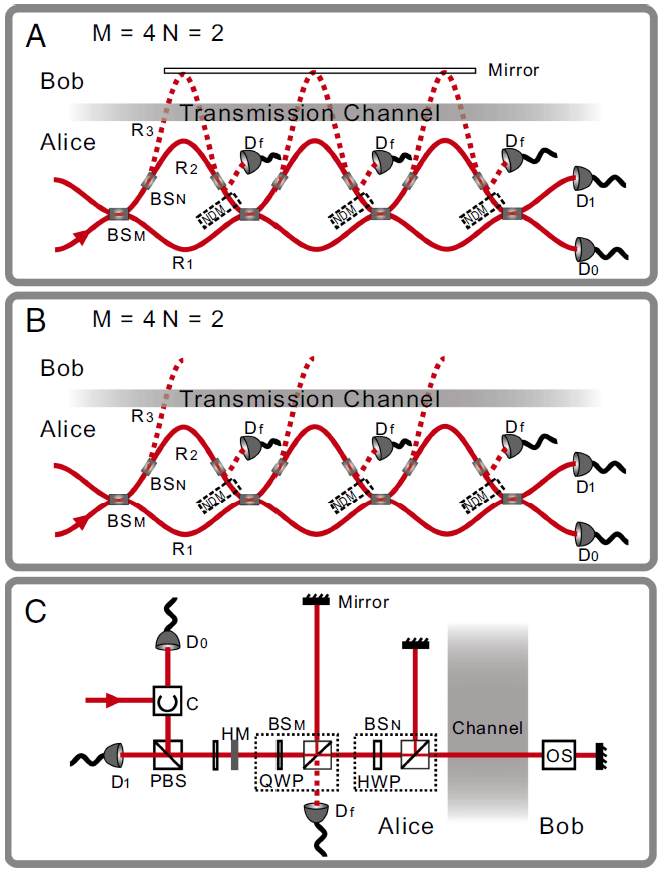Physicists first established a counterfactual quantum compound

Quantum communication in itself is a strange phenomenon. But in the variety of quanta there is one of the strangest types - counterfactual communication. This is a type of communication that does not involve the transfer of particles between the sender and receiver . This view is different from conventional quantum teleportation, because teleportation uses tangled particles. Usually, the particles need to be physically combined and confused in advance, before teleporting information between them to any distance, that is, the transfer of particles occurs one way or another. Alternatively, the particles can be confused at a distance, but with the mediation of the third particle, which must still physically go this way. In counterfactual compounds there is no such condition (just to remember that the photon here can be described as a wave function and not considered a particle).
The theoretical basis for the counterfactual quantum communication of physics was formulated in 2013. According to the description of the protocol , the transfer of information between Alice and Bob is carried out in empty space without the movement of physical particles due to measurements without interaction and a chain of Zeno's quantum effects .
')
The protocol description was a theoretical work, but now scientists have established a direct counterfactual connection for the first time in practice and actually transmitted information - a black and white image from point A to point B. The information carrier is the phase of light, and the photon is described by a wave function.
The key element of counterfactual communication is measurements without interaction — such a type of measurements in quantum mechanics, when the state of an object is recorded without the interaction of an object with a measuring device (in the interferometer).
The first experimental confirmation of measurements without interaction was obtained in 1981, although the accuracy of information transfer then did not exceed 50%. Using the Zeno effect in 1989, accuracy was increased to 100%. The quantum Zeno effect is that the decay time of the metastable quantum state of a certain system with a discrete energy spectrum directly depends on the frequency of events measuring its state. Thus, in the limiting case , under conditions of frequent observation, an unstable particle can never disintegrate . The effect was first predicted in 1954 by mathematician Alan Turing.
Zeno's quantum effect
The measurement scheme without interaction has already been checked for quantum computing and quantum cryptography . It can also be used to create connectivity between distantly separated atoms, write the authors of the scientific work.
Despite progress in studying the effects of quantum mechanics, scientists have so far failed to establish a direct counterfactual connection and transmit information without transferring physical particles. At least at one stage in the chain of communication channel but particles were used. This breakthrough was made by a group of scientists under the leadership of H. Salih from the National Center for Mathematics and Physics of Saudi Arabia, who decided this puzzle and in 2013 presented a direct counterfactual connection scheme without any particle transfer.
The discovery gave rise to a wave of heated debate in the scientific community. What has not existed so far is a real practical experiment that would confirm the theory of physicists from Saudi Arabia. And the Chinese colleagues conducted such an experiment . They successfully implemented the Saleh scheme using the quantum Zeno effect and a single-photon source.
The illustration below shows a schematic diagram of direct counterfactual quantum communication, in which the unstable system is constantly being measured so that the Zeno quantum effect appears. Figure A is a schematic diagram of the Saleh scheme. Figure B demonstrates that when a mirror is removed, the third possible route disappears. Figure C shows a diagram of a real experimental setup designed according to the simplified Saleh scheme using Michelson interferometers.

The layout of the experimental setup shows the diagram more clearly.

The bottom line is that the photon moves through the detectors, and each of them may or may not react to it (0 or 1). Thus, the information is encoded in the phase of light, and the intensity of the light does not matter.
The scientific work was published on May 9, 2017 in the journal Proceedings of the National Academy of Sciences (doi: 10.1073 / pnas.1614560114).
Source: https://habr.com/ru/post/370467/
All Articles